�
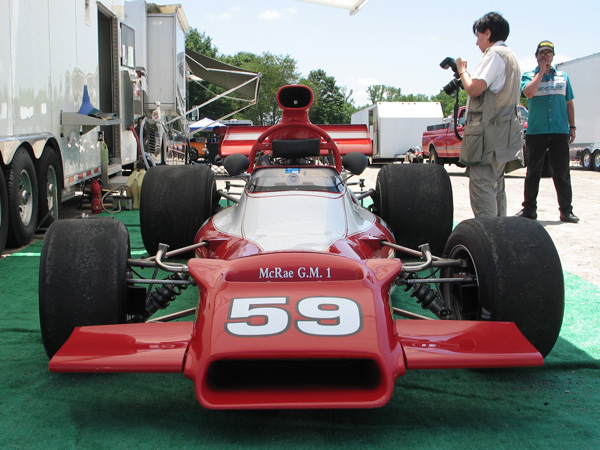
�
Jim Stengel's McRae GM-1 Formula 5000 Race Car
� Owner: Jim Stengel� Model: 1973 McRae GM-1
� Engine: small block Chevy V8 (5L)
� Race prepared by: Chris Schneider at Executive Auto Sport�
�
Graham McRae and McRae Cars Ltd.
��
Formula 5000 was like Can-Am, except for open-wheeled single-seaters. Sometimes called �
"F5000," this exciting racing class was introduced in 1968, and it was popular and �
competitive through the mid seventies. Rules were kept simple and minimal: engine �
displacement could not exceed 5.0 liters (normally aspirated). There were separate �
Formula 5000 race series in Europe, the United States, and Australasia. Prize money �
was big enough to induce teams to try all three, and in all three series big American �
V8 engines were dominant. �
�
McRae Cars Ltd. of Poole, Dorset was formed by successful kiwi Formula 5000 �
driver Graham McRae in 1972. �
�
Graham McRae was one of those rare drivers with all the skill and knowledge to build or �
extensively modify his own racecars. He had built several cars for his own use before�
becoming a professional driver. Then, on one particular occasion while testing a �
McLaren M10B at the Thruxton race circuit in Hampshire, McRae got into a spirited �
discussion with a rival team about the frustrations they were having with their Leda LT25. �
One thing led to another. Before long, McRae was challenged to help them develop a �
whole new racecar: the Leda LT27. This could not have pleased their very famous and �
gifted draftsman, Len Terry. In Terry's long career he had already gained a reputation �
as a top flight race designer for work at Lotus, Dan Gurney's AAR team, and BRM. Terry �
also co-authored the book "Racing Car Design and Development", which was published in �
1973. They didn't get along well, but the two men managed to work together and to �
accomplish quite a lot. Len Terry could draw brilliantly, but actually had very little�
experience with racecar development. Graham McRae's contributions were that he could �
precisely evaluate and articulate how a chassis or suspension was performing based on �
seat-of-the-pants feel, and he had great intuition on how to make improvements. �
Working together, Terry and McRae created the Leda LT27 and refined it into the McRae GM-1. �
�
�
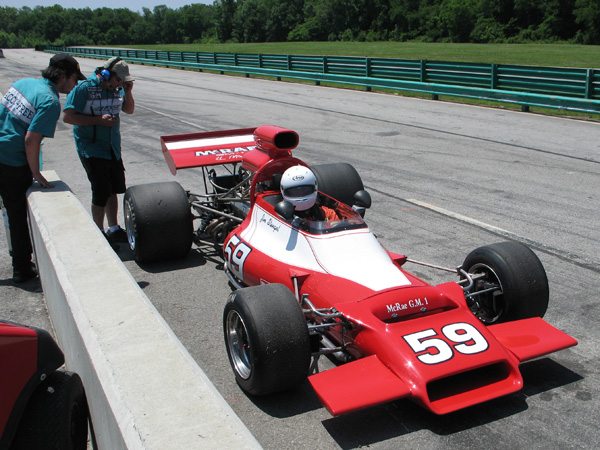
�
McRae GM-1 makes a brief stop on the way to the winner's podium.
�
�
The GM-1 was immediately successful. Graham McRae dominated the 1972 Formula 5000 calendar �
by driving the prototype GM-1 to championship victories in both the United States and also �
Australasia. (The "Tasman Series" was named for the Tasman sea, which separates �
Australia and New Zealand.) For good measure, McRae finished third in the European �
championship. In total, he won twelve of the twenty-eight races he entered in 1972. �
He followed up in 1973 with another Tasman Series championship victory and one race �
victory in the European championship. If 1973's Formula 5000 season was less successful, �
it's only fair to note that he had distractions. While supervising construction of �
cars for customers, he was racing in several series. The Granatelli family (of STP fame)�
recruited him to drive in the Indy 500, and although he retired from the race early with �
an engine failure he was named Rookie of the Year for 1973. He also tried his hand �
briefly in Formula One with the Williams (Iso-Marlboro) team.�
�
Meanwhile, McRae Cars built about fourteen additional GM-1 cars for sale. The GM-1 �
model was succeeded by the "GM-2", which followed modern trends such as utilizing �
dual radiators in side pods in lieu of a single radiator up front. However, the GM-2 �
wasn't nearly as successful as the GM-1. Other manufacturers, especially Lola, had �
upped the technological ante too far. McRae Cars Ltd. ultimately folded. �
�
The original GM-1 prototype that Graham McRae had driven to such glory was destroyed �
in a trailer fire, but nearly all of the rest of the production run are accounted �
for. With its powerful and economical engine, beautiful lines, and elegant chassis design�
the GM-1 remains a very highly-prized classic racecar. �
�
Please support the sponsoring companies who make www.BritishRaceCar.com possible, including:
�

�
Chassis Number 10
��
The McRae GM-1 featured here, chassis number 10, has never been wrecked and has had �
relatively little use. It was one of two GM-1's originally purchased by Quicksilver �
Racing of California, but as their back-up car it got little use. Its second owner, �
Rodney Green of Colorado, drove it in regional SCCA competition but didn't campaign�
it aggressively or for long. It was retired from competition in 1986, and twenty years �
later sold to Paul Hoey of Olympia Washington. In 2008 it was purchased by �
its current owner, enthusiastic vintage racer Jim Stengel.�
�
Jim Stengel has progressed through a variety of Formula Fords, Continentals, and S2000 �
cars over twenty years of racing. A Pratt & Miller RM-2 kept his interest for ten �
years, and the GM-1 is his introduction to big engines. He purchased GM-1 chassis �
number ten in 2008, and he has more recently purchased chassis number six as well. �
�
�
Enjoying this article? www.BritishRaceCar.com is partially funded through generous support from readers like you!
�
To contribute to our operating budget, please click here and follow the instructions.
�
(Suggested contribution is twenty bucks per year. Feel free to give more!)�
�
Number ten was in remarkable condition, but after sitting in storage for twenty �
years it needed a thorough going-over to make it safe and fun for vintage racing. �
Trusted advisor and fellow racer Chris Schneider of Executive Auto Sport�
in Easton Pennsylvania was the ideal person to tackle this job! Every single part �
needed to be taken apart and inspected. Many parts would ultimately need to be �
replaced or reconditioned. A vast depth and breadth of technical knowledge, experience,�
and specialized research were required. Schneider got in touch with Graham McRae�
himself, and in the ensuing year they've developed a long distance friendship and �
a continuing technical dialogue.�
�
Now, after putting the car back together, Executive Auto Sport takes care of all �
the tuning and preparation services right down to delivering the car to racetracks �
and helping Jim get buckled-in. Executive Auto Sport does the same for Jim with�
his Pratt & Miller and also a 1990 Oldsmobile SCCA-TransAm car. �
�
Chris Schneider graciously welcomed www.BritishRaceCar.com to inspect his work when �
we visited with him during the Heacock Classic Gold Cup Historic Races at Virginia�
International Raceway in June. In the photo captions below, we'll share what we �
learned, both about the original design and also about its restoration and �
preparation for vintage racing.�
�
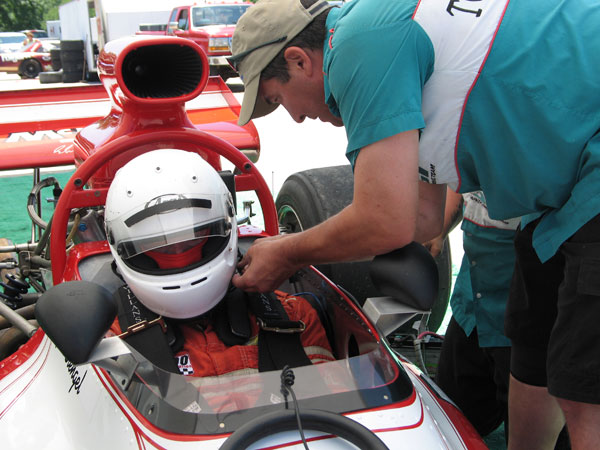
�
Chris Schneider and his staff at Executive Auto Sport Inc. help Jim Stengel get on track.
�
Features and Specifications
�| Engine: | �original small block Chevy engine with iron block and four bolt mains, �
rebuilt by Ted Wenz of Marcovicci-Wenz Engineering. The engine was �
de-stroked to 5 liters. Brodix aluminum cylinder heads with modified �
Moroso valve covers. MacKay fuel injection system with Lucas mechanical �
fuel metering unit. Lucas distributor. MSD6AL capacitive discharge ignition �
system. Dry sump lubrication system. Engine produces about 565hp. �
| �
| Cooling: | �original five row copper/brass radiator (forward mounted) and �
aluminum oil cooler (rear mounted). | �
| Exhaust: | �stainless steel four-into-one headers by Frank Nester at �
High Performance Vehicle Engineering, Easton PA. | �
| Transaxle: | �Hewland DG300 5-speed with cam and pawl differential, rebuilt by �
John Grubb at J and J Racing Ltd., Bally PA. A transmission oil cooler�
has been added. | �
| Front Susp.: | �unequal, unparallel wishbone suspension (nickel plated).�
Cast magnesium uprights with modified McLaren spindles.�
KONI adjustable coil-over racing shocks. �
Adjustable anti-sway bar.�
Custom steering rack with both rack and housing made from magnesium. | �
| Rear Susp.: | �dual lower links, single top links, and twin adjustable trailing links (all nickel plated).�
Cast magnesium uprights with modified McLaren spindles.�
KONI adjustable coil-over racing shocks. �
Adjustable anti-sway bar. | �
| Brakes: | �(master) Girling master cylinders with bias bar. � (front) outboard-mounted disc brakes with vented rotors. � (rear) Girling inboard-mounted disc brakes with vented rotors. | �
| Wheels/Tires: | �(front) Jongbloed modular racing wheels with Avon 10.0/22.0-13 bias-ply racing slicks. � (rear) modular racing wheels with Avon 16.2/26.0-15 bias-ply racing slicks. | �
| Instruments: | �(left to right) Stewart Warner fuel pressure gauge. Stewart Warner dual�
water temperature and oil pressure gauge. Stach electronic tachometer �
with tattletale. | �
| Fuel System: | �ATL fuel cell. High pressure electric fuel pump for starting. High pressure�
mechanical fuel pump for racing. | �
| Safety Eqmt: | �Willans six-point camlock safety harness. Shoulder belt mounting points modified�
to better suit HANS device. Racetech steering wheel with SPA Design quick release hub.�
Centralized, electrically triggered fire suppression system. | �
| Weight: | �~1350 pounds dry. 1640# with driver and fuel. | �
| Racing Class: | �Formula 5000 / SVRA 9FA | �
�
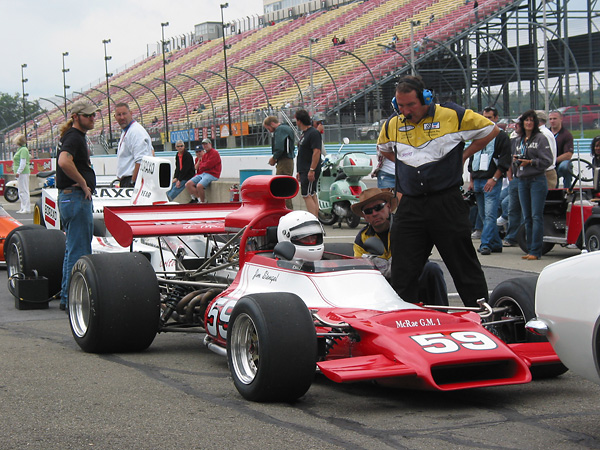
�
Jim Stengel prepares for the start of the Formula 5000 feature race of the 2009 U.S. Vintage Grand Prix
�
at Watkins Glen. Jim won the race handily, finishing in front of Rick Parson's white Lola T332, Ted Wenz's
�
orange McRae GM-1, and seven others. Best lap: 1:56.746 at 104.82mph (102.50mph for the race.)
�
 �
�
�
�
Engine Installation
��
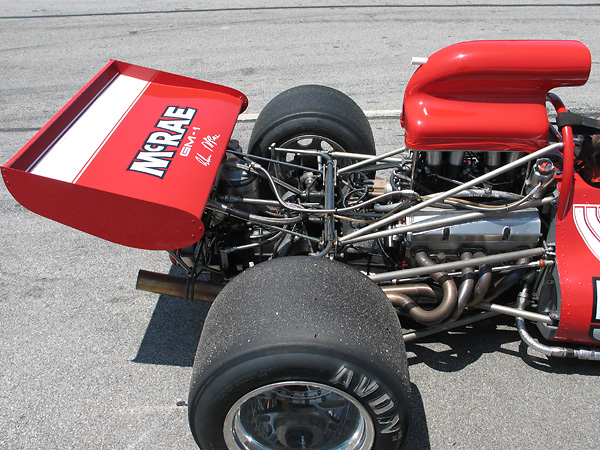
�
Small block Chevy engine with iron block and four bolt mains, de-stroked to 5.0L.
�
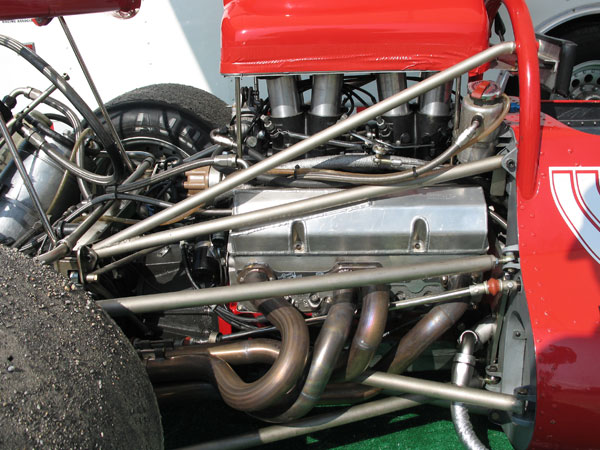
�
Brodix aluminum cylinder heads with modified Moroso valve covers.
�
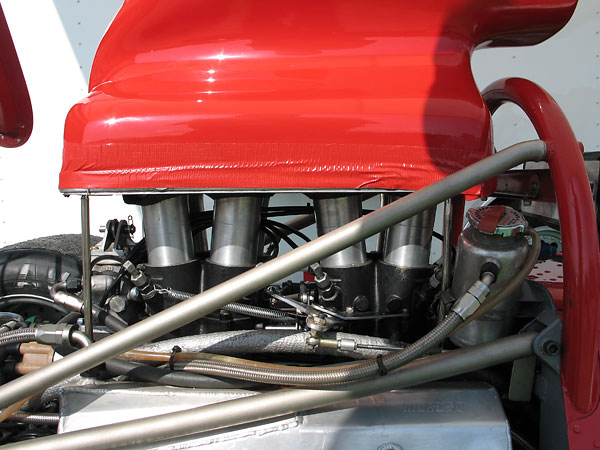
�
MacKay fuel injection system with Lucas mechanical metering unit.
�
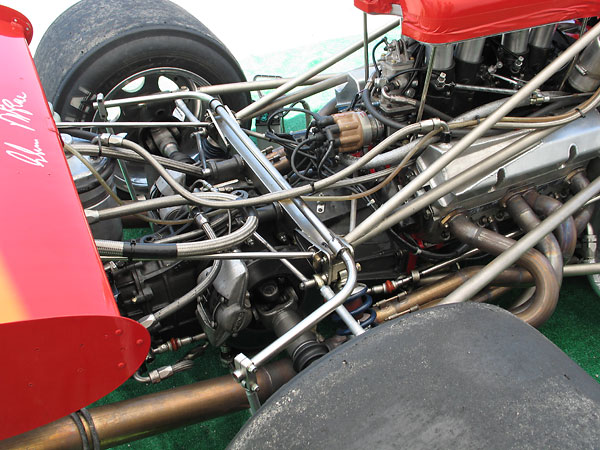
�
A horizontal "shortie" distributor was supplied as part of the MacKay / Lucas fuel injection kit.
�
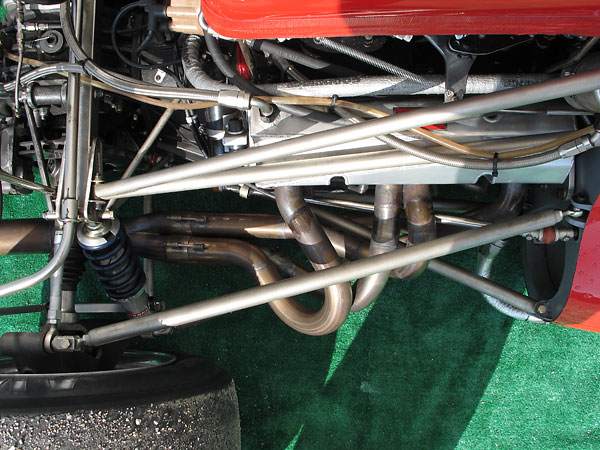
�
Stainless steel, four-into-one headers were expertly crafted to the original McRae pattern
�
by Frank Nester at High Performance Vehicle Engineering, Easton PA.
�
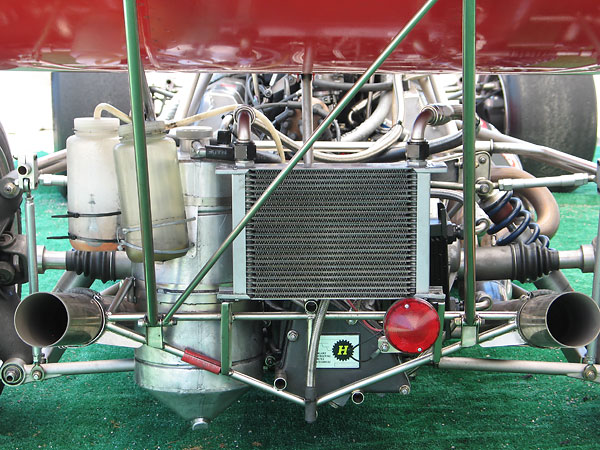
�
Hewland DG300 5-speed with cam and pawl differential, rebuilt by John Grubb at J and J Racing Ltd.
�
The large oil cooler is for the engine. The small, black, transmission oil cooler is a more modern addition.
�
On later racecars oil coolers and tanks are usually found further forward (e.g. in side pods) where they're
�
less likely to affect airflow under the wing and perhaps less vulnerable. This photo shows where McRae Cars
�
put the tank, although Graham McRae's own GM-1 had the tank behind the seat to reduce polar moment.
�
�
Suspension
��
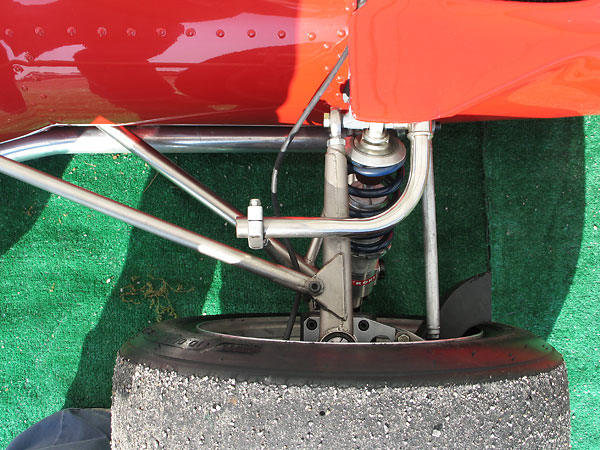
�
This car features nickel - not chrome - plated suspension links. That's an important distinction!
�
The McRae was built at about the same time racers were becoming aware of the great danger of
�
hydrogen embrittlement. In a nutshell, hydrogen produced and entrapped during the chrome plating
�
of steel makes parts far more likely to crack and to fail catastrophically. High alloy steels are much
�
more susceptible to the problem than mild steel. Formula One explicitly forbid chrome plating of
�
suspension components in 1973, and other racing organizations followed.
�
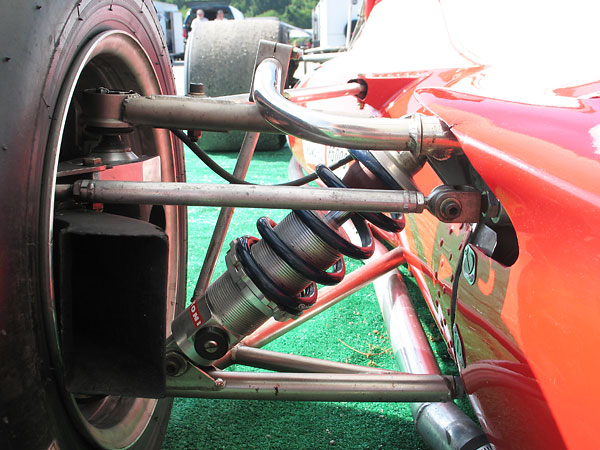
�
Outboard mounted front shock absorbers help keep costs down and ease tuning. Some earlier Leda
�
designs used inboard-mounted shock absorbers, but reportedly Leda never got the design kinks ironed out.
�
Here, the original Armstrong shock absorbers have been replaced with new KONI shocks. (Both bump and
�
rebound circuits are separately adjustable, whereas the Armstrongs were only adjustable on bump.)
�
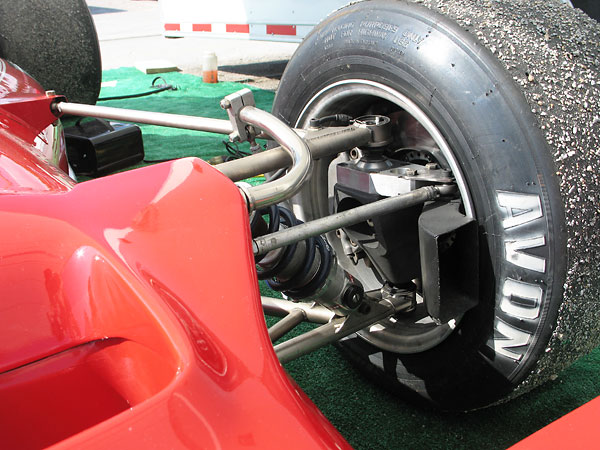
�
The wheel uprights are cast magnesium. Although they look quite similar to McLaren uprights, they're
�
dimensionally different. They've been carefully checked for cracks with Zyglo, and rebuilt with new
�
bearings and spindles. The new spindles are actually modified McLaren spindles.
�
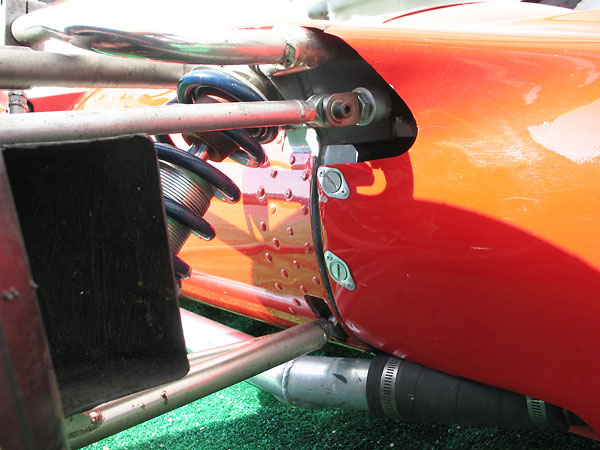
�
Brake cylinders and steering rack are mounted to the front bulkhead. The steering rack is a typical
�
Graham McRae detail; both the housing and the rack itself are constructed of magnesium.
�
They're built to be extremely lightweight because ounces add up to pounds!
�
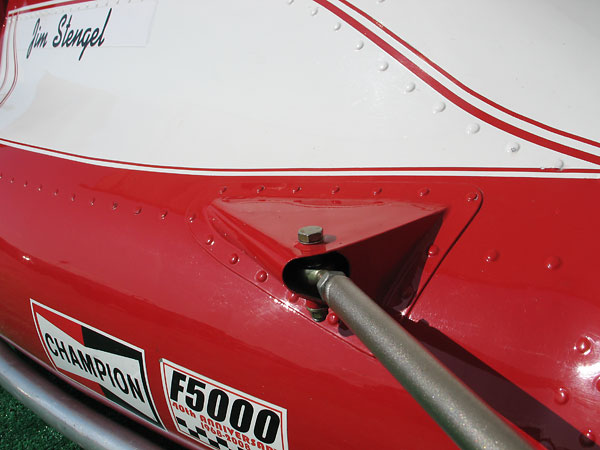
�
Aluminum and bucked rivets. Carbon fiber tubs wouldn't appear until the early eighties.
�
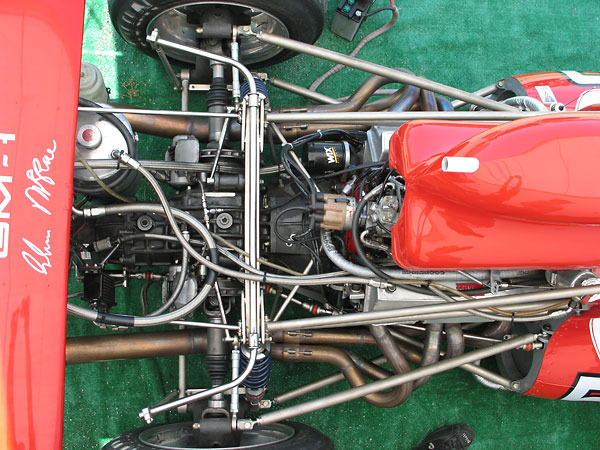
�
(We can't possibly get too many photos of these beautiful headers!)
�
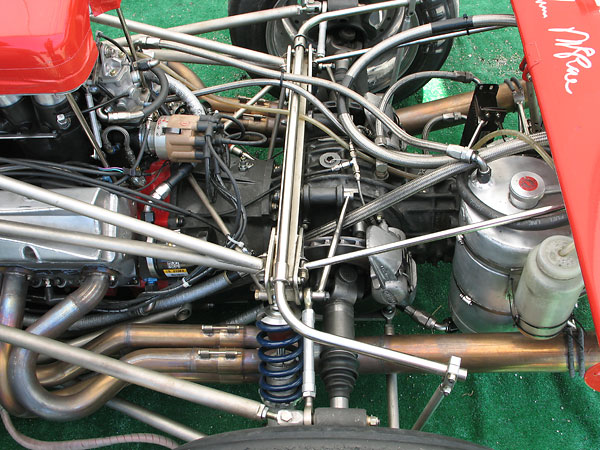
�
Few people would spot it, but these halfshafts are beefier than the ones that were originally fitted.
�
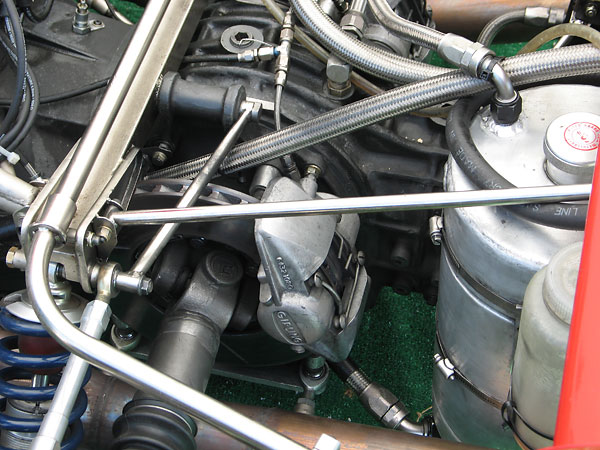
�
Girling inboard disc brakes. At right, Grand Prix Metalcraft Ltd. dry sump lubrication system reservoir.
�
�
Interior
��
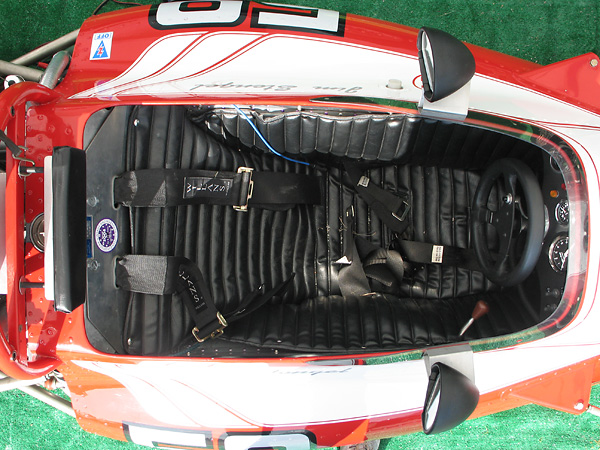
�
The roll hoop and its horizontal headrest support bar are original, but the Willans six-point safety harness
�
is modern, and its shoulder mounting points have been raised about three inches from the original height.
�
The gauges are (driver's left-to-right) are: fuel pressure, dual water temp / oil pressure, and tachometer.
�
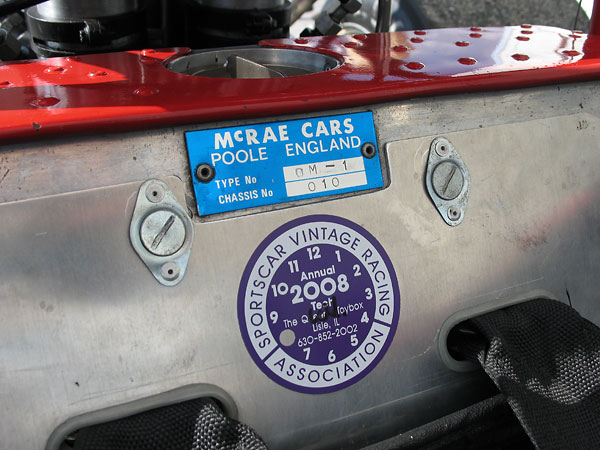
�
"McRae Cars, Poole England, Type No. GM-1, Chassis No. 010."
�
The fuel filler cap originally filled two 13 gallon fuel cells which were located on either side of the seat.
�
A new ATL fuel cell has been installed on the right-hand side. Some electronic modules, including an
�
MSD capacitive discharge ignition box and the pit radio, are discretely hidden on the left-hand side.
�
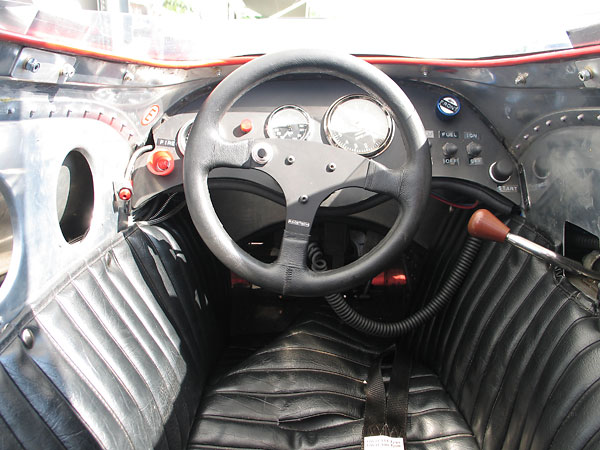
�
Switches, left to right: fire suppression (red pushbutton), pit radio (push-to-talk, on steering wheel),
�
brake bias (knob), "Light", "Fuel", and "Ignition" (toggle switches), and "Start" (black pushbutton.)
�
The car was originally equipped with an electrically-triggered, centralized fire suppression system,
�
which used CO2 whereas the modern system uses an extenguishing agent called DuPont FE36.
�
The mechanical fuel injection system needs very high fuel pressure (~150psi) to function optimally.
�
The fuel switch controls a high pressure electric pump, which is used to get the engine up to speed.
�
A crank-driven mechanical pump is used when actually racing. The switch turns off the electric pump.
�
A pushbutton switch for accessing the electronic tattletale features of the tach is hidden from view.�
�
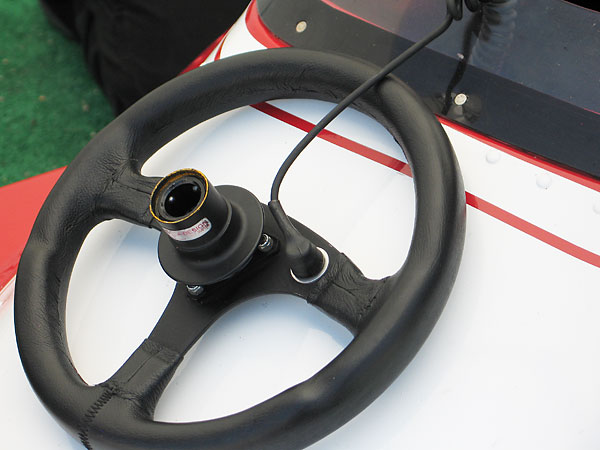
�
Racetech steering wheel with SPA Design quick release hub.
�
Exterior
��
�
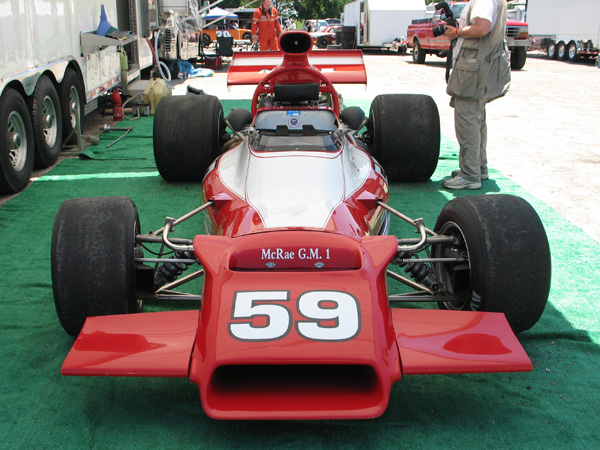
�
Big engines and tires, but small wings! The front wings don't even have end plates or Gurney flaps.
�
The GM-1 chassis wasn't designed to utilize a lot of downforce, so it would be obsolete soon.
�
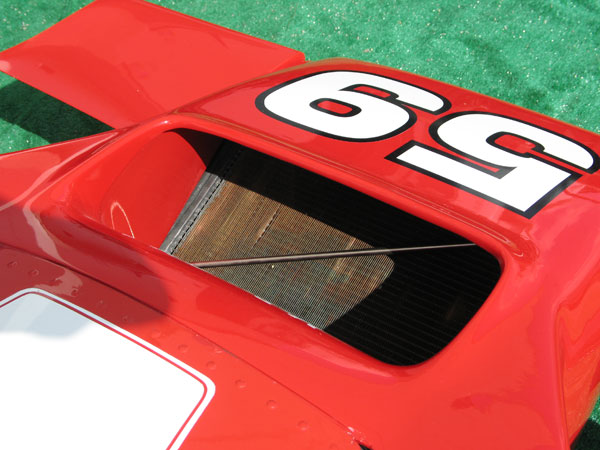
�
This original, five-row, copper and brass radiator is sufficient for sprint races, but not more.
�
In addition to bigger wings, the GM-2 model would feature dual radiators mounted in side pods.
�
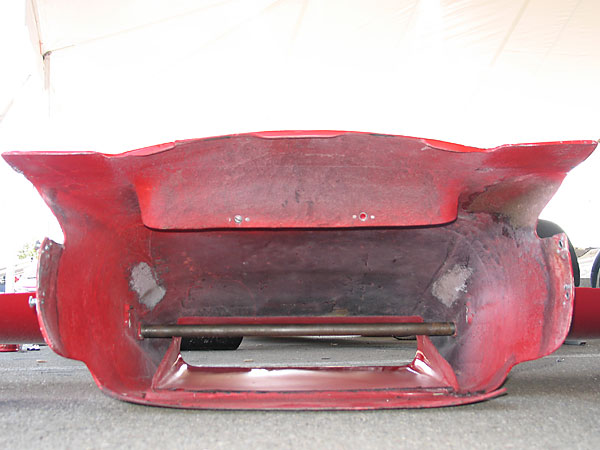
�
The nose cone is easily removed (via six Dzus clips) to access the radiator, and also the master cylinders.
�
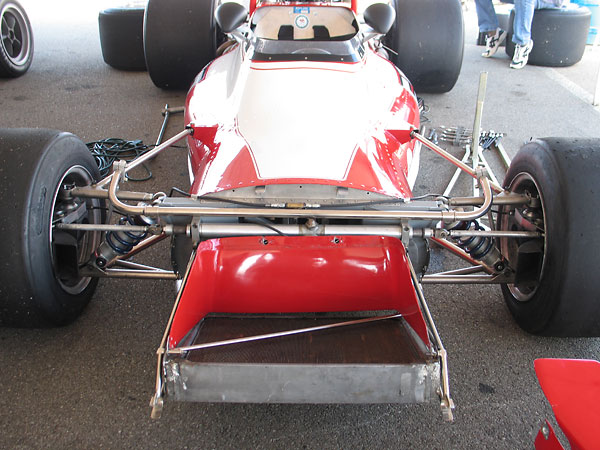
�
�
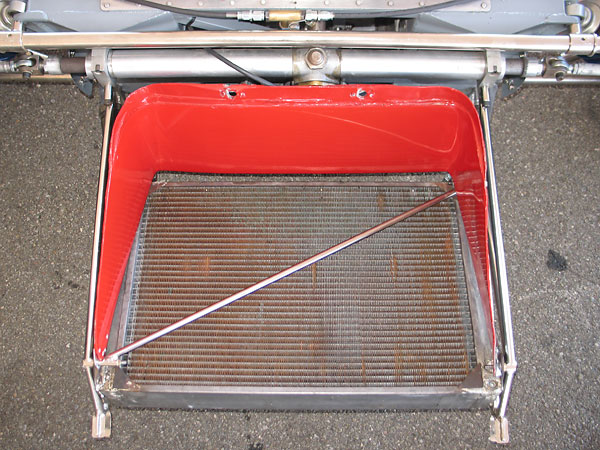
�
Just behind the radiator is a hinged deflector panel. (Shown here in the down position.)
�
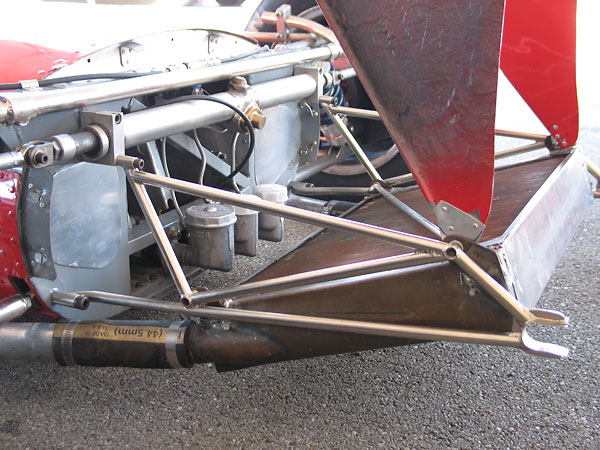
�
The air deflector swings up to provide easy access to the master cylinders.
�
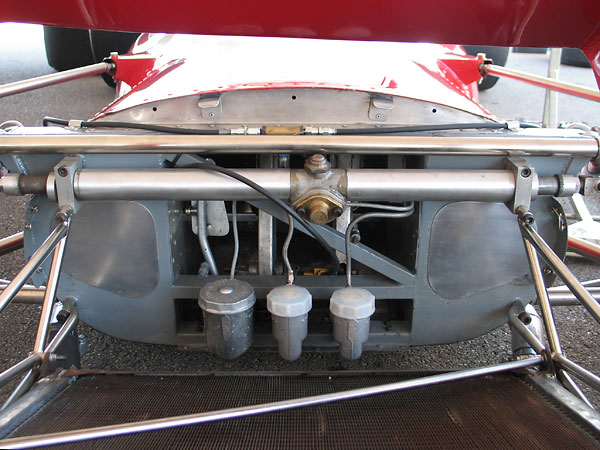
�
Girling master cylinders.
�
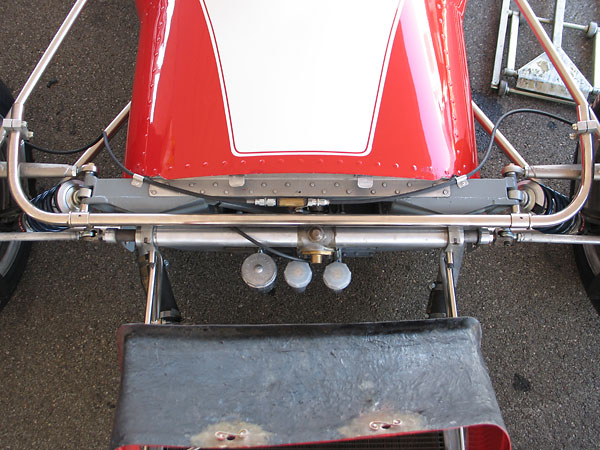
�
The front anti-sway bar is very conventionally designed.
�
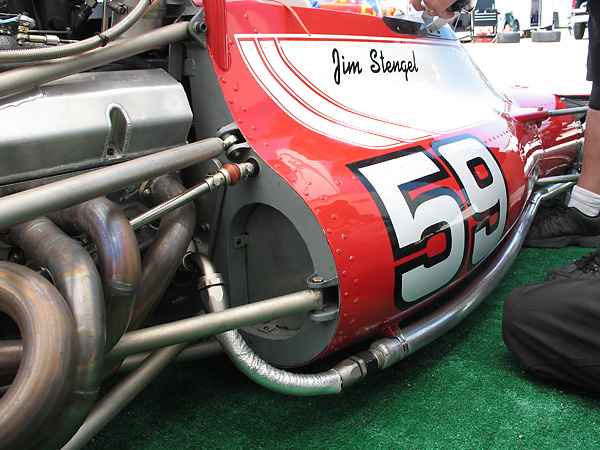
�
Cooling system plumbing on the outside of the chassis is exactly "as original".
�
Also shown is the rearmost of three bulkheads in the monocoque chassis.
�
They're elaborate fabrications of light gauge (0.032" and 0.049") steel.
�
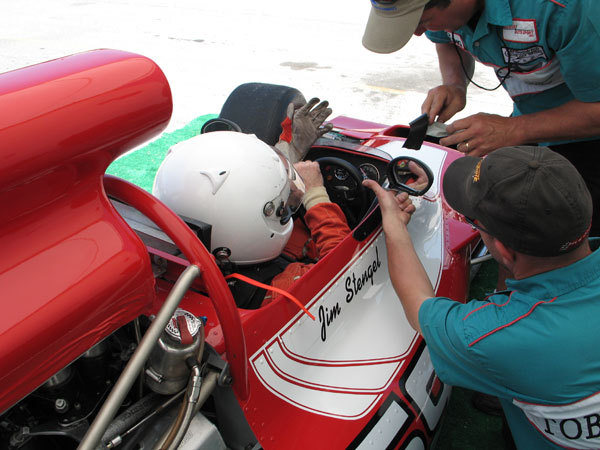
�
The monocoque's outer skin is beautifully sculpted in a relatively soft aluminum alloy (e.g. 3xxx series.)
�
Approximately twelve different pieces of thin sheet were oxyacetylene welded together to construct it.
�
The flatter interior panels and the floor were constructed from stronger heat-treatable alloys.
�
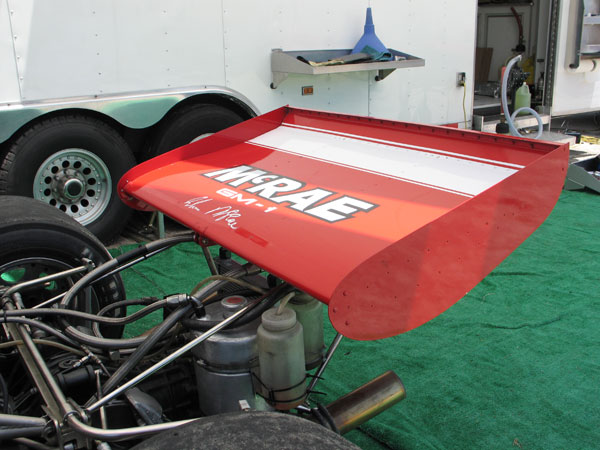
�
The purpose of racecar wings is to create aerodynamic downforce that translates into traction for cornering.
�
The trick is to maximize downforce without sacrificing too much speed to drag. The "Gurney flap" at the rear
�
edge of this wing remarkably improves its effectiveness. The upturned strip creates twin vortices immediately
�
behind its upper edge, and a low pressure area behind them. The results: airflow tends to stay more laminar
�
along the bottom surface of the wing and the wing can be tilted downward more aggressively for even more
�
downforce. Dan Gurney discovered this trick in 1971. It took a year for other teams to catch-on and copy him.
�
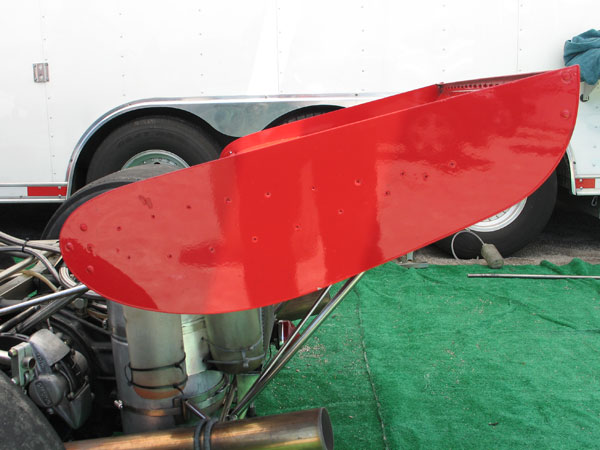
�
With higher pressure air above the wing and lower air pressure below, airflow around the ends of the wing
�
would inevitably occur if not blocked by end plates. The shape and size of the end plates determines their
�
effectiveness and also how much drag they cause. As the state of the art evolved, end plates were extended
�
progressively lower until they were at least three times the chord thickness below the lower wing surface.
�
(In other words, this wing's end plates would be considered small by even mid-seventies standards.)
�
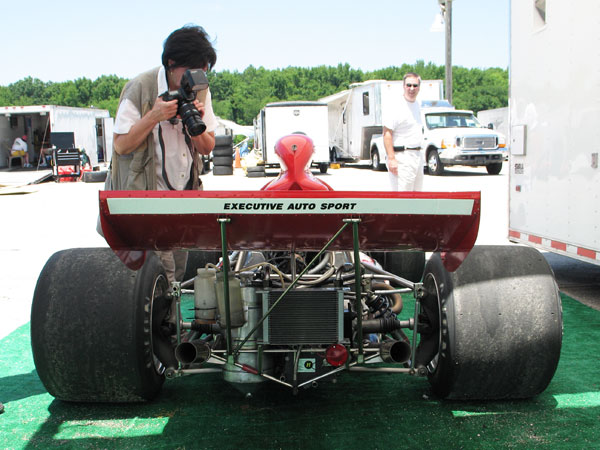
�
Ultimately, the rear wing can only be so effective because it's blocked by the engine, roll hoop, etc.
�
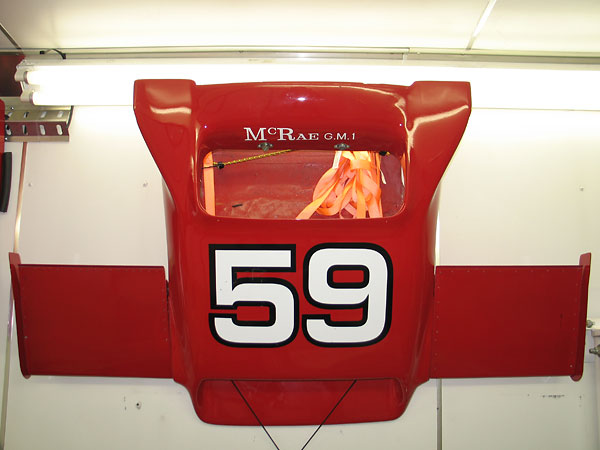
�
This nose cone is a spare and its design is a little different. Note that the wingslets feature "Gurneys"
�
and that it has end plates. This illustrates how the car would have been raced in 1974 or later.
�
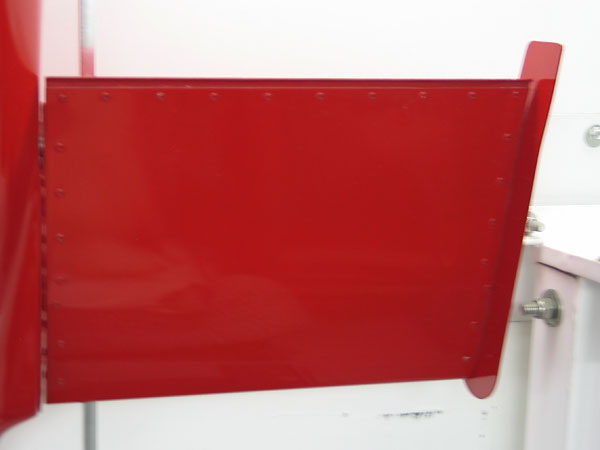
�
There are three selectable wing angle positions.
�
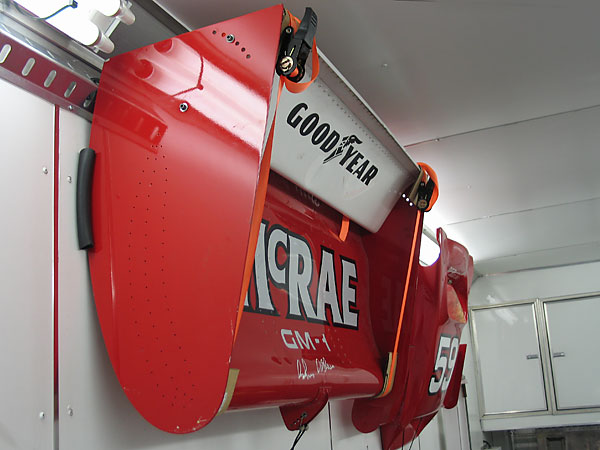
�
This is a much more aggressive rear wing assembly. The smaller airfoil at the back is called a Fowler flap.
�
Note the recess in the main airfoil below the Fowler. The two airfoil shapes are designed to work together.
�
They're adjustable too: the whole assembly has five selectable positions, and the Fowler has six positions.
�
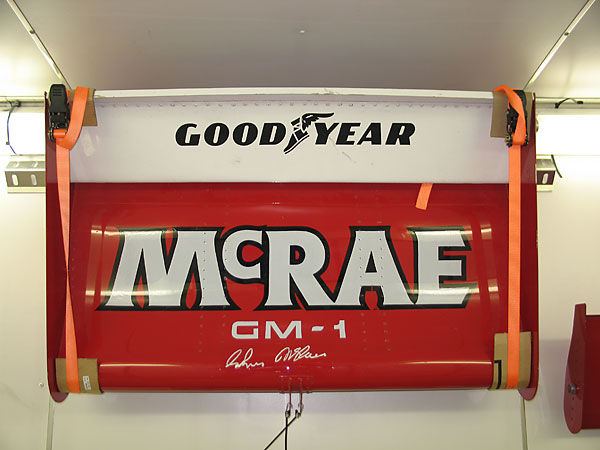
�
Yes, that's really Graham McRae's autograph.
�
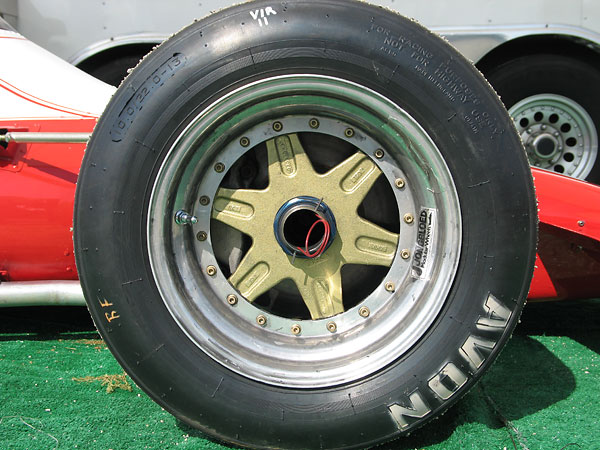
�
Front: Jongbloed modular racing wheels with Avon 10.0/22.0-13 bias-ply racing slicks.
�
On this wheel, the center section is magnesium and the two rim halves are aluminum.
�
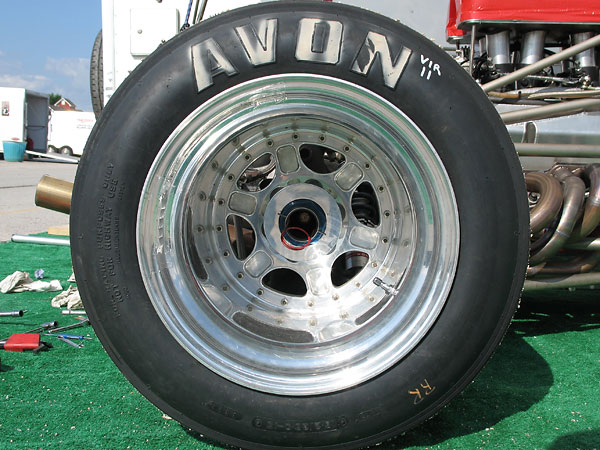
�
Rear: modular racing wheels with Avon 16.2/26.0-15 bias-ply racing slicks.
�
(Note: the photos show the wheels that were on the car when we visited. They represent two of three sets
�
Jim owns for the car. The third set are three-piece, all-magnesium Melmag wheels. These were THE wheel
�
associated with Formula 5000 in the early seventies. They were lightweight and available in wide widths.
�
Melmags were glued together without bolts or rivets. Adhesives are great in shear, but not so strong in
�
tension. They also break down over time. The Melmags are cool, but they don't get raced-on anymore!)
�
�
All photos shown here are from June 2009, when we viewed the car at The Heacock Classic Gold Cup at �
Virginia International Raceway, or from September 2009 when we viewed the car at The US Vintage Grand �
Prix at Watkins Glen. All photos by Curtis Jacobson for BritishRaceCar.com, copyright 2009. �
All rights reserved.
�
| If you liked this article, you'll probably also enjoy these: | �|||||
 | �
Ron Goldleaf '68 WRE Shadow | �
 | �
Paul Dudiak '69 McKee Mk12 | �
 | �
Eric Haga '70 Lola T190 | �
| You're invited to discuss anything you've seen here on The British Racecar Motorsports Forum! | �|||||
�
Notice: all the articles and almost all the photos on BritishRacecar.com are by Curtis Jacobson.
�
(Photos that aren't by Curtis are explicitly credited.) Reproduction without prior written permission is prohibited.
�
Contact us to purchase images or reproduction permission. Higher resolution images are optionally available.
�

 �
�